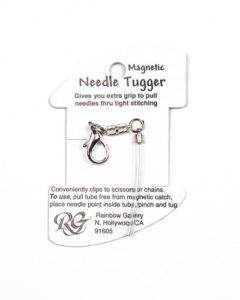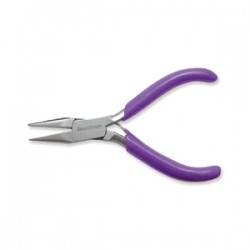
Let’s face it, we all need a little help sometimes. Our needles go through the back of stitches just a little too tight and they are hard to pull through. Or your needle is going through a dirty hole and it gets stuck. Those are the times you need help.
This help is in the form of a needle puller. These tools allow you to grip the needle and complete its movement. You won’t use them on every stitch but they will make your life less frustrating when you do need them.
In today’s article I’ll look at several options and go over the good and bad of each. You can effectively use any of these and which you choose is up to you, but you do need one in your tool kit.
In order to work any thread puller must be able to grip the needle. For all but the Needle Tugger this means the surface must be a bit rough.

Shelf Liner: The first puller I hadwas a 1″ square of foamy shelf liner. I got it as a gift at a guild meeting. The liner was an open mesh with foam areas on it, looking like the picture above. Con-tact makes it and you buy it in rolls. You place it between two fingers and put it on either side of the needle. Pros: Cheap and you can make many from one roll and cut them to the size you want Cons: Holes are bigger than needle diameter so you must grip along needle sides, may be cut too small to be useful
White Balloon:Yes a balloon. Even a small one will be big enough to grip your needle. To use, place the needle between the sides of the balloon’s body. Grasp firmly and pull. Pros: Cheap and really easy to find in bulk. Easy to replace Cons: Balloon must be white or dye may transfer onto threads. Long skinny balloons are harder to use (too thin); use round balloons.
Surgical Gloves: You may use these in your work. One gets put on your hand when you need to pull the needle. Because surgical gloves are slightly textured they act the way the balloon does. Do not use the clear plastic gloves you see in delis. They are like plastic bags on your hands and are too smooth to grip. Pros: This just improves the grip of your hands so you will be pulling the needle out just as you always have. They come in many sizes. Cons: You need to cut ends of two fingers or use a complete glove on your hand
Needle Tugger: (pictured at top of article) This little gadget from Rainbow Gallery works differently than the other pullers. It has a narrow clear plastic tube. The needle goes in the plastic tube and you tug to move it. This tool is made to sit on your scissors or chatelaine. It has a lobster clasp to attach it. The tugger is attached to the clasp with a magnet. It needs to be removed from the clasp to be used. Pros: Always around if you attach it to something you are using. Easy to use.Cons: Easy to lose if you don’t use a chatelaine or use multiple scissors. Hard to use if only a little of the needle is showing.

Mini Chain Nose Pliers: (pictured above) Pliers for jewelry making, which is what you want, come with many different types of ends. The ones that work best as needle grippers are called chain nose pliers. They come in two types: straight and bent. While both will work, the straight give you more gripping surface and are preferred. You also want to avoid the versions with long-noses because they will be too unwieldy. Jewelry pliers are made to work with small things and hold them securely. The flat insides of these pliers will let you hold the needle. They amplify your strength, as all pliers do, and put your hand away from the surface so the needle can be pulled out. I like the mini size, which is only about 3″ long. Pros:Easy to use, can grip even if only a small amount of needle is showing Cons: More expensive and navigating the huge number of tools can be confusing
About Janet M Perry
Janet Perry is the Internet's leading authority on needlepoint. She designs, teaches and writes, getting raves from her fans for her innovative techniques, extensive knowledge and generous teaching style. A leading writer of stitch guides, she blogs here and lives on an island in the northeast corner of the SF Bay with her family

Or an old fashion thimble to push it thru. I use a rubber tipped thimble to push troublesome needles thru. This way I do not harm or scratch or bend the needle.
I find a small pair of surgical hemostats works great
I love my mini needle nose plyers. I have arthritis in my fingers and practically no strength. I can wield the plyers in my palm and easily pull needles through the tightest of stitches.